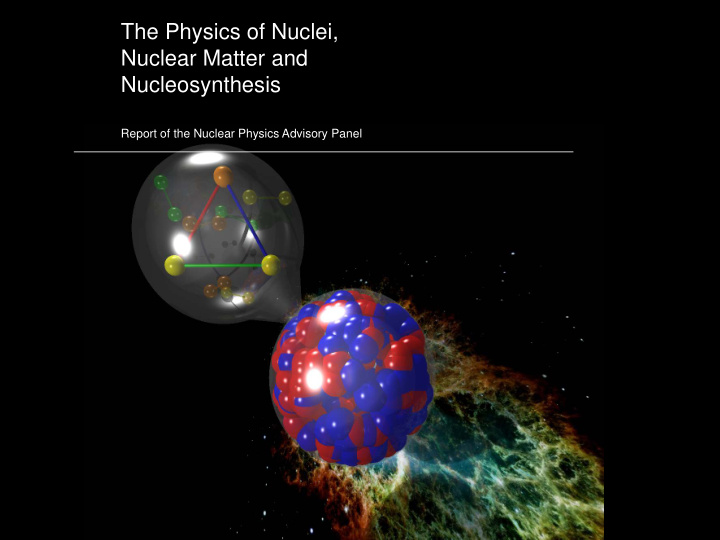



The Physics of Nuclei, Nuclear Matter and Nucleosynthesis Report of the Nuclear Physics Advisory Panel
Advice to PPAN – via the Nuclear Physics Advisory Panel Science Priorities Funding Facilities Projects
What are the Origins of the Elements? How, and where, were the heavy elements synthesised? Science What are the key reaction processes that drive explosive astrophysical events such as supernovae, and X-ray bursts? What is the equation-of-state of compact matter in neutron stars? What are the nuclear processes, and main astrophysical sites, that produce the γ -ray emitting radionuclides observed in our galaxy? How do nuclear reactions influence the evolution of massive stars, and how do they contribute to observed elemental abundances? What is the Nature of Nuclear Matter? What are the limits of nuclear existence? How do simple patterns emerge in complex nuclei? Can nuclei be described in terms of our understanding of the underlying fundamental interactions? What is the equation-of-state of nuclear matter? How does the ordering of quantum states change in extremely unstable nuclei? Are there new forms of structure and symmetry at the limits of nuclear existence? How do the properties of hadrons and the quark- gluon plasma emerge from fundamental interactions? What is the mechanism for confining quarks and gluons in strongly interacting particles (hadrons)? What is the structure of the proton and neutron and how do hadrons get their mass and spin? Can we understand the excitation spectra of hadrons from the quark-quark interaction? Do exotic hadrons (multiquark states, hybrid mesons and glueballs) exist? What are the phases of strongly interacting matter and what is the nature of the quark-gluon plasma? How do nuclear forces arise from QCD?
Funding and Priorities [Context]: There is a funding “crisis” at STFC Further cuts to the programme should be anticipated PPAN original advice – think about how to construct science programme in a level budget. Nuclear Physics Budget ~£10M (£3M projects)
9000 8000 Full Funding 7000 Current Projects Funding (k£) 6000 5000 4000 3000 2000 1000 0 2006 2008 2010 2012 2014 2016 2018 2020 2022 Year
Proposal for Revised Costs including profiling Based on potential scientific impact, balance of programme, leadership, strategic importance……… 9000 Original: £35M 8000 Full Funding over 10 years Current Projects 7000 Funding (k£) Prioritised Funding 6000 5000 New: £23.5M 4000 over 10 years 3000 2000 1000 reduction to 65% 0 2006 2008 2010 2012 2014 2016 2018 2020 2022 Year
Future Project Priorities: NuSTAR-programme • As part of FAIR NuSTAR is STFCs current top priority • Upgrades to R 3 B, HISPEC, DESPEC + investment in experiments on the storage ring EXL, ILIMA • Access drip-line nuclei (light systems) r-process nuclei (medium mass) • NuSTAR has been set by the community as its highest priority • Serves a large fraction of the community scientifically ISOL-UK • Plan to build equipment to be based at HIE-ISOLDE and SPIRAL2 for measurements with ISOL beams – nuclear astrophysics, transfer studies, collective properties. • Potentially involvement in the HIE-ISOLDE upgrade • Build up expertise in ISOL measurements – in anticipation of EURISOL • Possibility to use equipment at ISAC2, FRIB
Future Project Priorities: AGATA • Key piece of experimental infrastructure: used at NuSTAR, SPIRAL2, Legnaro • Will serve the physics interests of a significant fraction of the community. • built in 2 stages 1pi and 4pi – the latter more important for SP2. • Will produce enhanced sensitivity for many measurements PANDA Disc DIRC • PANDA One of STFCs highest priorities • PANDA approved by PPAN, project to build the Disc DIRC funded for feasibility study – if successful then invited to submit full proposal • Key part of PANDA detector • Science: Measurement of GPDs (access to 3D nature of the nucleon) exotic particles (mesons), heavy glueballs……
Future Project Priorities: JLAB-upgrade • Highest priority in the NSAC strategic plan • 6 GeV – 12 GeV requires upgrade to equipment total cost $310M. • Natural progression of the Jlab programme • Science: mesons with exotic quantum numbers, GPDs ELENA • Construction of underground facility at Boulby • Measurement of nuclear cross sections in Gamow Window (LUNA) • UK leadership in a very important scientific area • Funded for feasibility study
Possible priority order:- NuSTAR upgrade + EXL, ILIMA: PANDA ISOL (Instrumentation for HIE-ISOLDE and SPIRAL2): JLAB-upgrade AGATA ELENA Questions: Is the above order right? Are there any caveats? What are the balance of programme issues? What are the consequences for the cross community posts if one area is cut? …………
What to do about theory? 1) Nothing? 2) Something? One suggestion: Fund, from the grants stream AFs/PDRFs in theory in 2010 and 2012 Could apply to work in any group Vetted by NPGP If no candidates make quality cut – no award Need to find funds.
The Physics of Nuclei, Nuclear Matter and Nucleosynthesis Report of the Nuclear Physics Advisory Panel
Recommend
More recommend